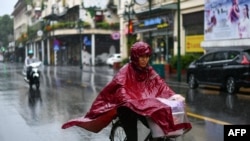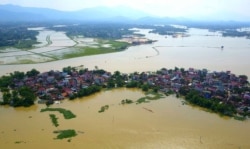Back-to-back tropical storms left at least 28 people dead in Vietnam over the past week, raising fears climate change has brought the Southeast Asian country a spike in severe weather.
Vietnam lies in one of the world’s five “cyclone centers” and receives an average of 4.3 storms and at least three floods per year, market analysis firm Indochina Research and Consulting estimates. Five other tropical storms have approached Vietnam so far this year.
“The problem isn’t so much a little more damage this year or a little less damage this year,” said Adam McCarty, chief economist with Mekong Economics in Hanoi, “The problem is that it’s trending upwards and this is a climate change problem.”
Even in a 2011 report on the country, the U.N. Food and Agriculture Organization said typhoons, which have winds higher than those of tropical storms, “tend to occur more frequently.”
The country of 97 million people is now one of the most “hazard-prone” countries in the world, according to the Climatelinks.org database operated by the U.S. Agency for International Development. It should expect higher temperatures, increased “intensity of extreme weather events” and a rise in sea levels, Climatelinks says.
Tropical storm Linfa had killed at least 21 and left 14 others missing as of Sunday as it crossed central Vietnam. The second storm, Nangka, hit the same region Wednesday. Twenty-eight people were reported dead.
Storms this month have damaged at least 25,000 houses and 84,000 hectares of cropland, local media report. They struck an agricultural zone known for rice, coconuts and tropical fruit, often grown in low-lying areas that are likely to flood.
A landslide at a hydropower dam project in the central Vietnamese province of Thua Thien Hue left 17 workers missing, the ruling Communist Party-run Nhan Dan Online news website reported. Thirteen rescue workers in another province hit by landslides were missing, as well.
Landslides strike the mountains every year, said Ralf Matthaes, a long-term expatriate and founder of the Infocus Mekong Research consultancy in Ho Chi Minh City.
“This is common ground,” Matthaes said. “We’re in the middle of the rainy season anyway, so I don’t think it’s anything that’s out of the ordinary.”
Most tropical storms make landfall in central Vietnam, sparing the capital, Hanoi, the financial hub Ho Chi Minh City, and the country’s manufacturing zones. Central parts of the long north-to-south country are relatively poor, meaning shoddier houses with high odds of flooding.
The frequency of dangerous storms has made government disaster relief “systematic,” McCarty said. Infrastructure is improving too, while agriculture is becoming more mechanized and people are moving from farms to cities, he added.
Most people in the country keep tabs on damage from each big storm and help victims if there’s a way, analysts in Vietnam say, but they’ve grown nonchalant about the threat of new storms.
“I think that they are used to the storms,” said Nguyen Thanh Trung, Center for International Studies director at the University of Social Sciences and Humanities in Ho Chi Minh City. “In Vietnam, when we hear about the storms in the news on social media, the first things we pay attention to are the consequences and the aftermath.”
People in relatively well-off Ho Chi Minh City monitor the media for storm aftermath news partly so they can donate to victims, Nguyen said. Donation processes have become routinized in Vietnam because of the regularity of storms, he said.






